|
|

Civil War Re-enactors Refurbish Early Morse
for Latter-day CW ops
(October 1, 1998)
Authentic telegraph sounders, circa 1863, were used at the Gettysburg re-enactment July 4-6, 1998. The Union and Confederate armies were connected by an authentic single wire with ground return.
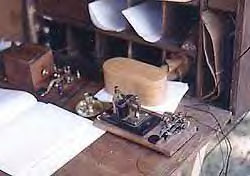 Authentic telegraph sounders, circa 1863, were used at
the Gettysburg re-enactment July 4-6, 1998. The Union and Confederate
armies were connected by an authentic single wire with ground
return.
Authentic telegraph sounders, circa 1863, were used at
the Gettysburg re-enactment July 4-6, 1998. The Union and Confederate
armies were connected by an authentic single wire with ground
return. | |
Early telegraphy had a role in the July 4, 1998, re-enactment of the famous Civil War battle at Gettysburg, Pennsylvania; held to commemorate the 135th anniversary of the historic military event. Of course, early Morse telegraphy used the 1844 American Morse code, although the numbers of those proficient in that early system are dwindling. But Civil War re-enactor Walt Mathers, a member of the Washington-Baltimore Chapter of the Morse Telegraph Club, is among those encouraging hams to join in the fun, to ~~ as he punned ~~ "spark a renewed interest in the early history of the telegraph."
Mathers says that a little modern-day sleight of hand lets hams proficient in International Morse code ~ the "radio" code; to more easily copy the clicks and clacks of American Morse "wire" code. Tiny, solid-state oscillators render "old" Morse sounds into "new" CW tones that a radiotelegrapher can more easily copy. "It opens up a great opportunity for ham operators to become part of re-enactments," Mathers said. "It's a great breakthrough."
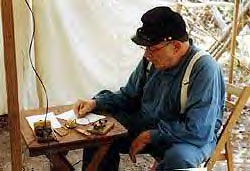 Roger Kuchera, K1TG, of Naugatuck, Connecticut, served as telegraph operator to the Union Army general during the Gettysburg re-enactment of Pickett's Charge of July 3, 1863 on July 4, 1998. Kuchera was one of more than 15,000 re-enactors. The instrument is an authentic one.
Roger Kuchera, K1TG, of Naugatuck, Connecticut, served as telegraph operator to the Union Army general during the Gettysburg re-enactment of Pickett's Charge of July 3, 1863 on July 4, 1998. Kuchera was one of more than 15,000 re-enactors. The instrument is an authentic one.
| |
Mathers says his club debuted the Morse oscillators at the big Gettysburg event. "This development will enable operators who heretofore could only read code from radio beeps to read from the clacking of period telegraph sounders and relays," he said. "The process is undetectable to the public." Tim Glaser, KD8TC, built five of the units for Gettysburg. "The circuit is just a 555 tone oscillator that I added a volume control and a earplug to," Glaser explained. "I got all the parts at Radio Shack and built it up on some perf board, cut the plugs off the earplugs, and hardwired the whole thing together." Glaser says he made the boxes for "click-challenged people like me."
For the Gettysburg re-enactment, Mathers and his signal corps cohorts also used a single-wire, ground return system that is historically accurate. "It worked like a charm," Mathers reported.
Power for the system came from wet cells. "The whole length of the line used 60 V," he said. "This is the approximate voltage used over the lines in the 1860s."
At Gettysburg, provisions were made for eight stations to be up and operating over the 2.5 miles of wire at any given time. "If a station had to be closed at any time for lack of operators, the howls went up from the generals," he reported, "as the distances were appreciable between the various camps."
Mathers said both commanding generals enjoyed a dedicated private line, while the various Federal and Confederate divisions were connected to their respective commands by a line erected within their own interior lines.
"The opportunity to acquire the knowledge of period telegraphy was open to re-enactors of all ages regardless of sex," he pointed out. Mathers said that using the 1860s Civil War army dot code, most re-enactors can be taught to send and receive messages in an hour or less. At Gettysburg, Mathers said, re-enactors used three different codes ~ American Morse, International (or Continental) Morse, and the Army dot code. The dot code was developed in the 1860s, he said, because of difficulty between the Army Signal Corps and the semi-private US Military Telegraph Service. Executives of the Northern telegraph companies were afraid the military would take over their lines, Mathers explained. "Everything of importance was sent in cipher. Union generals weren't shown the secret codes. Even Lincoln was out of the loop."
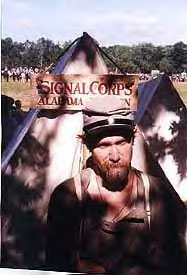 John Lovell, a re-enactor from Athens, Alabama, looks convincing as a member of the Confederate Signal Corps at Gettysburg.
John Lovell, a re-enactor from Athens, Alabama, looks convincing as a member of the Confederate Signal Corps at Gettysburg.
| |
In the South, army signalers were expected to be proficient not only with flag and torch, but with the key and sounder, Mathers said.
The dot code is the simplest of the three and is a spinoff of the flag codes: a flag to the left is a one, a flag to the right a two, and a flag to the front is a three. Each letter of the alphabet is assigned its own combination of ones and twos (sound familiar, computer fans?--Ed). For example, the letter "B" is represented by "1221." Combinations of threes are used to indicate end marks ~ end of words, sentences, messages. The operator simply taps the key once, twice or three times, as appropriate.
The early American Morse is a four-element code employing dots, dashes, extended dashes, and spaces between dots to convey meaning. The two-element International code used today was developed in Berlin in the early 1850s, according to Mathers.
Mathers and other re-enactors also have become fluent in recreating a 19th century mode of written expression, as in this e-mail message (Mathers and his Morse colleagues call them "E-Wires") he to a fellow re-enactor following the Gettysburg event. The communication echoes the need for more Morse operators at future re-enactments:
Captain Hugh Pruitt
Assistant Adjutant
General Hood's Texas Brigade
Sir:
Yours of the 16th. instant is recv'd at these head-quarters.
As to answering your statement below, concerning the telegraph "up and running" at Gettysburg, please allow me to share some little known information concerning that story. From the first of January of this year, we had more than 25 operators express'g an interest in the event but, as the event unfolded, only a handful were on-hand to provide service and, a few of those were compelled (due to prior commitments or unit allegiance) to divide their attention between the telegraph and other branches of the service. Needless to say, our superintendent, Kevin Saville, N7JKD, of Everett Washington, had his hands full, training folks in the event's wire protocol and was continuously challenged with scheduling operators for service with the different commands. Kevin also supervised the line construction and system wiring. Mike Pechera, WA8BXN, of Ohio, also provided much needed electronic equipment and was responsible for assisting Superintendent Saville in establishing the entire communication system.
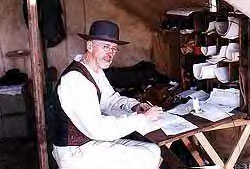 Jim Wilson, K4BAV, served as a telegraph operator to the Confederate Army in this July 3, 1863, re-enactment. He's connected by wire to the Union Army.
Jim Wilson, K4BAV, served as a telegraph operator to the Confederate Army in this July 3, 1863, re-enactment. He's connected by wire to the Union Army.
| |
A few of our operators, coming solely for the telegraph experience, staid beside their instruments from sun-up until well into the night, from Thursday through Sunday without relief. Fortunately we were able to see that these stalwart partisans were fed and sheltered, but they enjoyed little else save for the satisfaction that they were contributing to the success of the event.
Our system consisted of more than 2-1/2 miles of wire stung out in a huge semi-circle on the Confederate side of the field plus more lines radiating beyond the Confederate head-quarters to accommodate the Federal head-quarters and one of its distant divisions. The line in all supported hook-ups for eight instruments, which only accounted for one half of our on-hand supply. Roger Reinke of Alexandria, Va., alone, supplied us with eight instruments from his personal collection. We amassed several additional miles of un-used reserve wire. We wanted for naught excepting our most dearest resource; people. Our operators handled a brisk traffic on both sides of the lines, which included a private wire between over-all commanding generals' Chuck Hillsman and Dana Heim. We sorely and continually regret the want of more operators than instruments. For instance, the line reached the Confederate artillery command, was tested and attached to an instrument, but no message traffic was conducted on account of our operator shortage. Company E of the 3rd. Regt Confederate Engineers (from Southern California) swiftly and cheerfully erected two towering wire lance poles allowing the wire to span the heavily traffick'd supply roads ensuring communication with the army's artillery park. We simply didn't have enough operators to go around. This scenario, as you well know, was repeated for the most part throughout the course of the event in your own division. I was inform'd that an operator arrived in your camp just in time to see your Division off on a reconnoitre-in-force.
Despite the lack of adequate numbers in personnel, Gettysburg 135th produced, for the first time in re-enactment history, an authentic electrical communications system that operated over a single strand of wire with a ground rod (galvanized metal stake) driven into the earth on both ends for the return of electricity at 60 volts DC (1860s period voltage) and was powered by a deep cycle wet cell battery and a specially made converter box to boost the current to the desired voltage. The inventor of this converter, Amateur Radio operator Edward Trump, AL7N, of Fairbanks, Alaska, also manufactured reproduction 1860s telegraph equipments from brass and wood, and out-right donated these instruments for the success of this and future events. Ed attended in spirit.
Additionally, and again for the first time ever at a Civil War re-enactment, Ed and others located and obtained schematics to build nifty little devices called oscillators which enabled operators, (who could only read code by radio tone) to copy messages while still using 'clacking' period telegraph instruments. One of our associates, Tim Glaser, KD8TC, of West "Western 'til July 20th, 1863" Virginia led his amateur radio club in the manufacture of five oscillators with attaching hidden ear plugs. Joined by Roger Kuchera, K1TG, of Connecticut they provided six such set-ups for service. This co-operation enabled certain operators to copy text who otherwise would not have been up to the challenge of Morse receiving instruments, i.e. sounders and relays. On-lookers were not aware of this special feature as the operator would always wear his ear-plug well-concealled and away from his audience.
This milestone now makes it possible for any Civil War re-enactment organization to acquire the services of amateur "ham" radio operators.
The Signal Corps Association Reenactor's Division (SCARD) and the long-established Morse Telegraph Club will be able to assist the operators you enlist by acting as a clearing house to scout out the necessary instruments and wire, required to effect a link, or hook-up, at future national events.
This Gettysburg gathering was unique in that we were able to collect telegraph operators from across the country and raise a semi-organized corps of telegraph operators in under six months. E-wire was the vehicle. Although none of these folks had worked to-gether prior to the 135th., they all put their heart and souls into an effort which we now know will serve as the benchmark for our re-enactment community's future national event communication system. I trust that for the benefit of the re-enactment community you will continue to share your comments with us (Proverbs 12:1). Indeed, they are most hoped and wished for, from one who has enjoyed and wishes to remain, Sir, your most obedient servant,
Walt Mathers
Late Chief Signal Officer & Captain
Army of Northern Virginia
Gettysburg 135th.
|
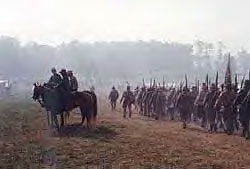 |
"Gentlemen, prepare for battle!" Thousands of
Confederate troops ready themselves as on the morning of July 3,
1863, to face their Union counterparts. Telegraph messages flew fast
and furious! |
| A re-enactor posing as Confederate General Robert
E. Lee on his mount, Traveler (left), inspects the troops during the
Gettysburg re-enactment, simulating July 3, 1863. |
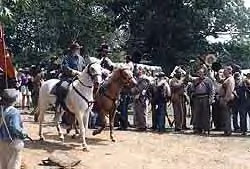 |
Mathers cautions that living history can become addictive to participants and even their family members. "It's one of the last inexpensive and wholesome family activities that involved history and camping!" he enthuses.
Re-enactors don't have to know the code to get involved (although Mathers or others will be happy to teach newcomers the simple "dot" code).
"It's really another time and space," Mathers says of historical re-enacting, "but it has roots to us all." Mathers says the areas of living history activities include most everything you can imagine, from theater, equestrian activities, art, music, photography, transportation, even retail sales. "In fact, you can practically find everything you'd like to do in the 20th century--except 100 years removed." Want to be a teamster, firefighter, constable, or postmistress? There's sure to be something to suit everyone. Interested? Contact any of our state representatives at this site or the Adjustant & Inspector General's Office via "E Wire" at A & IG Office to learn of on-going activities in your region.
Reprint Courtesy of:
ARRL The National Association for Amateur Radio
WWW.ARRL.ORG
Photo Credit: Jim Wilson
SIGNAL CORPS. ASSOCIATION (1860 to 1865)
MARLEY CREEK ARCHIVES, 13 BEACH ROAD, GLEN BURNIE, MARYLAND 21060
For Archives Information:
For site comments contact:
|







































 Authentic telegraph sounders, circa 1863, were used at
the Gettysburg re-enactment July 4-6, 1998. The Union and Confederate
armies were connected by an authentic single wire with ground
return.
Authentic telegraph sounders, circa 1863, were used at
the Gettysburg re-enactment July 4-6, 1998. The Union and Confederate
armies were connected by an authentic single wire with ground
return. Roger Kuchera, K1TG, of Naugatuck, Connecticut, served as telegraph operator to the Union Army general during the Gettysburg re-enactment of Pickett's Charge of July 3, 1863 on July 4, 1998. Kuchera was one of more than 15,000 re-enactors. The instrument is an authentic one.
Roger Kuchera, K1TG, of Naugatuck, Connecticut, served as telegraph operator to the Union Army general during the Gettysburg re-enactment of Pickett's Charge of July 3, 1863 on July 4, 1998. Kuchera was one of more than 15,000 re-enactors. The instrument is an authentic one.
 John Lovell, a re-enactor from Athens, Alabama, looks convincing as a member of the Confederate Signal Corps at Gettysburg.
John Lovell, a re-enactor from Athens, Alabama, looks convincing as a member of the Confederate Signal Corps at Gettysburg.
 Jim Wilson, K4BAV, served as a telegraph operator to the Confederate Army in this July 3, 1863, re-enactment. He's connected by wire to the Union Army.
Jim Wilson, K4BAV, served as a telegraph operator to the Confederate Army in this July 3, 1863, re-enactment. He's connected by wire to the Union Army.

